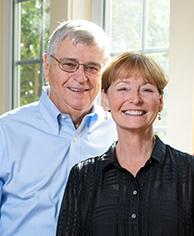Flexible Giving, Inspired by Students
James ’72 and Muguette Alder

Jim Alder’s 40th Reunion in 2012 marked a new era in his involvement with MIT. He began to volunteer as an educational counselor, and he and his spouse, Muguette, made their first planned gift to the Institute, a charitable remainder trust (CRUT). In 2019, the couple formed a new planned giving strategy and established an MIT Donor-Advised Fund to align with their changing priorities.
Getting to know MIT students.
A CRUT provides income to a donor and their beneficiaries, and when it terminates, the gift goes to a designated cause at MIT. The Alders directed their CRUT to undergraduate scholarships. “Supporting scholarships is especially important to me, as I had financial issues while at MIT,” says Jim. “We established the CRUT wanting to donate to MIT and expecting to need additional income to support our retirement lifestyle.”
Establishing a CRUT, like other planned gifts to MIT, welcomed the couple into the Katharine Dexter McCormick (1904) Society (KDMS). “From day one, everyone was so wonderful and welcoming toward us,” says Muguette. “Hearing students’ incredible stories at events like the annual KDMS member appreciation brunch is what made me want to get more involved with MIT.” Getting to know MIT students in that capacity, as well as Jim’s work as an educational counselor, inspired the Alders to also establish an endowed scholarship fund in 2015.
Evolving priorities.
As the Alders’ engagement with MIT grew, they realized that their planned giving strategy needed to change. “We discovered that we don’t need the additional income from the CRUT in retirement,” says Jim. “Terminating the CRUT, as we did in 2019, provides MIT the money sooner to support undergraduate scholarships while giving us a one-time additional charitable tax deduction.”
“Given our interest in continuing to support MIT, establishing a Donor-Advised Fund was a logical next step.” — Jim Alder
In 2019, the Alders also invested in a different planned giving instrument: an MIT Donor-Advised Fund (DAF). “Given our interest in continuing to support MIT, establishing a DAF was a logical next step,” says Jim. “We will accumulate money in the fund over the next several years and watch that money grow through the MIT endowment’s track record of returns. Our current plan is to use some of our fund to support other charities, but give most of it to MIT.”
The importance of supporting MIT.
Beyond their planned giving strategy, the Alders’ personal experience influenced their giving to MIT when they established a graduate fellowship in the Department of Brain and Cognitive Sciences in 2017. “We have family members with brain-related medical conditions and understand the impact of these conditions both on individuals and society. We are optimistic there will be research breakthroughs in the near future, with MIT playing a key role,” says Jim.
The Alders suggest that if others are considering a gift to MIT, a CRUT through the Office of Gift Planning is a great starting place—especially for scholarship support. “At MIT events, I love to hear from the students about their background, current activities, and future plans,” says Muguette. Jim agrees: “Hearing from MIT students will tilt you pretty quickly toward the advantages and the value in the money you will donate, no matter what type of gift you make.”
